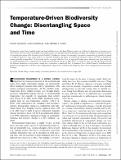Files in this item
Temperature-driven biodiversity change : disentangling space and time
Item metadata
| dc.contributor.author | Waldock, Conor | |
| dc.contributor.author | Dornelas, Maria | |
| dc.contributor.author | Bates, Amanda E | |
| dc.date.accessioned | 2019-01-22T12:30:05Z | |
| dc.date.available | 2019-01-22T12:30:05Z | |
| dc.date.issued | 2018-11-01 | |
| dc.identifier | 257443974 | |
| dc.identifier | 08632f3a-6b12-4705-b595-ef0b43e7c8d0 | |
| dc.identifier | 000455168300010 | |
| dc.identifier.citation | Waldock , C , Dornelas , M & Bates , A E 2018 , ' Temperature-driven biodiversity change : disentangling space and time ' , Bioscience , vol. 68 , no. 11 , pp. 873-884 . https://doi.org/10.1093/biosci/biy096 | en |
| dc.identifier.issn | 0006-3568 | |
| dc.identifier.other | RIS: urn:AE7EA5E469AAF46F1B27B7D8F8EF5EBD | |
| dc.identifier.uri | https://hdl.handle.net/10023/16913 | |
| dc.description | CW was supported by the Natural Environmental Research Council (grant no. NE/L002531/1). AEB is supported by the Canada Research Chairs program. MD is grateful for support through Scottish Funding Council's (Marine Alliance for Science and Technology for Scotland grant no. HR09011), the European Research Council grant nos. AdG-250189 (BioTIME) and PoC-727440 (BioCHANGE). | en |
| dc.description.abstract | Temperature regimes have multiple spatial and temporal dimensions that have different impacts on biodiversity. Signatures of warming across these dimensions may contribute uniquely to the large-scale species redistributions and abundance changes that underpin community dynamics. A comprehensive review of the literature reveals that 86% of studies were focused on community responses to temperature aggregated over spatial or temporal dimensions (e.g., mean, median, or extremes). Therefore, the effects of temperature variation in space and time on biodiversity remain generally unquantified. In the present article, we argue that this focus on aggregated temperature measures may limit advancing our understanding of how communities are being altered by climate change. In light of this, we map the cause-and-effect pathways between the different dimensions of temperature change and communities in space and time. A broadened focus, shifted toward a multidimensional perspective of temperature, will allow better interpretation and prediction of biodiversity change and more robust management and conservation strategies. | |
| dc.format.extent | 12 | |
| dc.format.extent | 3406017 | |
| dc.language.iso | eng | |
| dc.relation.ispartof | Bioscience | en |
| dc.subject | QH301 Biology | en |
| dc.subject | T-NDAS | en |
| dc.subject | SDG 13 - Climate Action | en |
| dc.subject.lcc | QH301 | en |
| dc.title | Temperature-driven biodiversity change : disentangling space and time | en |
| dc.type | Journal article | en |
| dc.contributor.sponsor | European Research Council | en |
| dc.contributor.sponsor | European Research Council | en |
| dc.contributor.institution | University of St Andrews. School of Biology | en |
| dc.contributor.institution | University of St Andrews. Centre for Biological Diversity | en |
| dc.contributor.institution | University of St Andrews. Fish Behaviour and Biodiversity Research Group | en |
| dc.contributor.institution | University of St Andrews. Marine Alliance for Science & Technology Scotland | en |
| dc.identifier.doi | 10.1093/biosci/biy096 | |
| dc.description.status | Peer reviewed | en |
| dc.identifier.grantnumber | 250189 | en |
| dc.identifier.grantnumber | 727440 | en |
This item appears in the following Collection(s)
Items in the St Andrews Research Repository are protected by copyright, with all rights reserved, unless otherwise indicated.

